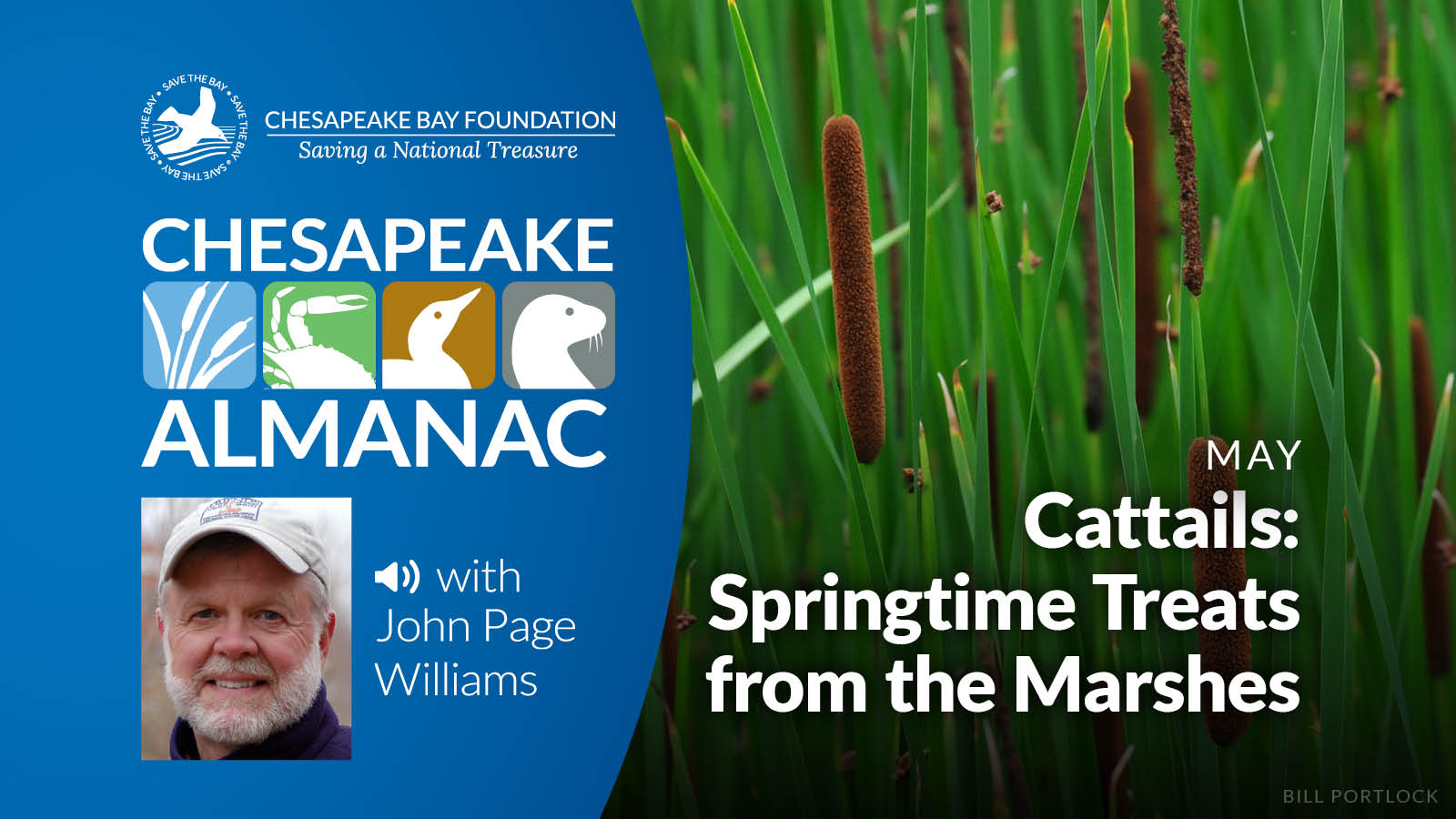
Podcast Transcript: Chesapeake Almanac
Episode 9: May: Cattails—Springtime Treats from the Marshes
Copyright © John Page Williams Jr. All rights reserved.
This is John Page Williams with another reading from Chesapeake Almanac. The month is May and this sketch is entitled, "Cattails: Springtime Treats from the Marshes."
Grace Ann Gray teaches biology at Southern Senior High School in Anne Arundel County, down below Annapolis. Generally each year she sets up a spring field trip with the Chesapeake Bay Foundation. She and her students meet a CBF trip leader in Galesville, where they put the canoes over into the West River to paddle around the corner at the Hartge Yacht Yard and up Lerch Creek.
People on the creek may find it strange to see two dozen high school students sloshing around a marsh on a Wednesday morning, pulling cattail heads over into plastic bags and shaking them. But the students are learning two profound lessons. The first is that Lerch Creek is getting fresher, which says something about the way estuaries work. The second is that there are some unorthodox but tasty and nutritious foods along the margins of the Bay.
Euell Gibbons ate a lot of cattails in his time, many of them from the Chesapeake. He called the plants "supermarkets of the swamps" and gave them a chapter in Stalking the Wild Asparagus. His particular joy in them, as in all his wild food foraging, was the relationship between the forager and the natural community around him or her. The Southern High students come back from Lerch Creek with an understanding of Gibbons and his writings that goes far beyond his old cereal commercials.
There are two species of cattail common to the Bay country: narrowleaf (Typha angustifolia) and broadleaf (T. latifolia). The narrowleaf is more widespread, occurring in the tidal fresh portions of all the rivers and at the back edges of upper Bay salt marshes. Each of its leaves is about an inch wide. This is basically a freshwater species, but it can tolerate low salt concentrations. Thus it is a good indicator of freshwater input to brackish waterways like Lerch Creek. Broadleaf cattails are strictly freshwater plants, so they grow in rivulets, streams, branches, and roadside ditches. Their leaves are about two inches wide.
Cattails are perennial, growing each year from rootstocks in the mod. The narrowleaf begins sprouting earlier, generally in mid-April. The broadleaf comes a couple of weeks later. From then on until mid-June, the stalk hearts are good additions to a salad. Grasp a stalk near its base and pull it gently but firmly from the mud. Peel the leaves back to the tender white heart. Wash it and eat it. It is crunchy and mild, with a flavor somewhat like cucumber.
Toward mid-May, the narrowleaf bloom spikes begin to emerge on the plants' central stalks. The stalk hearts of such plants will no longer be tender, but the tips of the spikes make a good cooked vegetable. The top is the male part of the bloom, six to eight inches long, growing an inch or so above the familiar furry female cattail on the stalk. Cut off firm male spikes from several plants. Steam them in salted water for 10 minutes, add a little melted butter, and eat them down to the central stalks, as you would corn on the cob.
By late May, the male spikes swell and soften as they begin to release their bright yellow pollen to the wind. Now is the time for those not allergic to pollen to emulate the Southern High students. Put a small bag over the bloom spike, bend the stalk over, and shake hard. Some of the pollen will fall into the bag. Fifteen or 20 minutes' work will yield a cup or so. Mix the pollen with flour in any standard pancake or waffle recipe. (Substitute pollen for one-fourth of the flour called for in the recipe.) The result is golden yellow cakes with good quality protein and a distinctive, pleasant flavor.
After the pollen flies, the male spike disintegrates. The female spike, now fertilized, swells and begins the long business of developing its fluffy seeds. The astute forager then shifts attention to broadleaf cattails, which will just be blooming. They will be good for another three weeks or so. The real die-hard forager can wrap surplus spikes in a bag and freeze them to eat in the winter at a table with an arrangement of dried cattails on it.
It would be a great mistake, thought, to suggest that cattails have value only as food and table decoration for humans. The plants are important to the river communities as both food and habitat for a variety of birds, mammals, insects, and even fish. Even so, during this month, they offer us a great opportunity to be part of the food web, partners in the intimate relationships of the Chesapeake's living community.
For more happenings around the Bay in May see our other Chesapeake Almanac podcasts and read our blog posts "The Dirt on Soil Health" and "A Mahogany Tide in May."
Subscribe to this podcast at https://chesapeake-almanac.captivate.fm/listen


